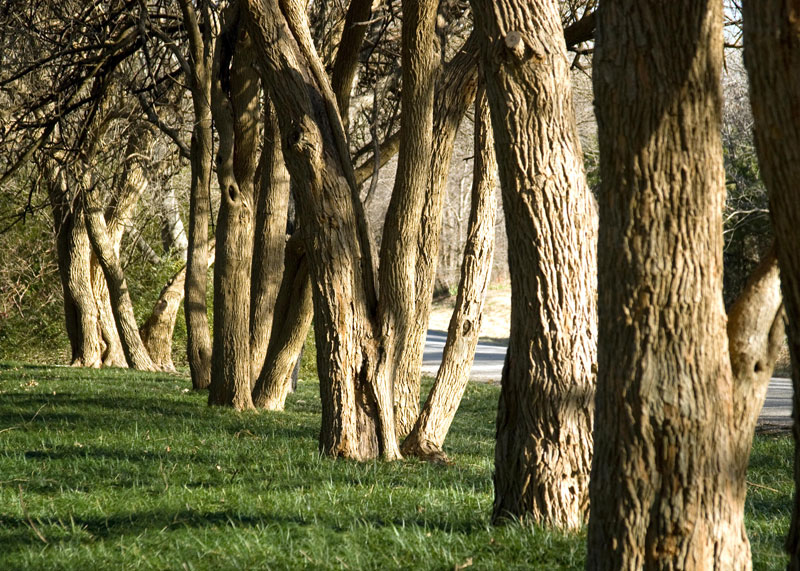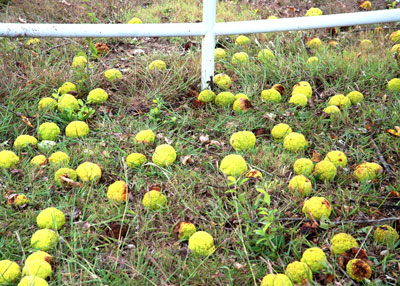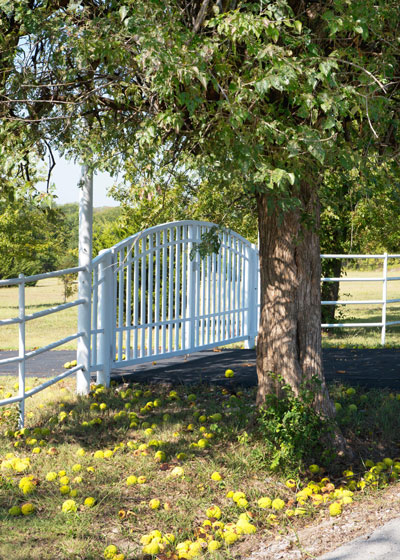Just call it durable

It’s a venerable old goat, this tree that grows along riverbanks, roadsides, rocky slopes and hillside meadows. Most commonly, you’ll see it growing in old fence rows, sometimes planted on purpose, and sometimes the result of chance seedlings.
The one thing that’s sure: you will see this tree the next time that you drive around town – it’s scattered almost everywhere.
And the other thing that’s almost as certain: you will not see this tree the next time you stop by a local nursery. It doesn’t transplant easily, and they certainly don’t obligate valuable retail space to it.
My wife grew up on a beautiful farm 30 miles south of Columbus, Ohio. Her dad was a hard-working, patient man, but this tree tested him about as much as anything could.

As for its name…
Botanically, it’s Maclura pomifera. In spite of its resemblance to oranges, the plant is actually in family Moraceae, the Mulberry Family. Each fruit is a dense cluster of hundreds of smaller individual fruits.
In the Midwest folks call it “hedge apple” or simply “hedge.” You’ll also hear people refer to it as “Osage orange,” and somewhere along the line we Texans started calling it “bois d’arc,” for “wood of the bow.” Osage Indians made bows from its wood.
Fun facts
• Bois d’arc wood is extremely resistant to rotting. That’s why it was used by our great-grandparents as leveling blocks for their pier-and-beam houses. You could cut it off into short sections of stout trunk and use them to support an entire house, its belongings and family held safely up off the cold ground. Those old blocks are still out there, carrying their loads 100 years later.
• Bois d’arc was also used by early farmers for fence posts – it wouldn’t rot. The next time you see a gnarly antique rural fence, those crooked old posts are probably bois d’arc. (If they’re straight, they’re probably one of the species of junipers.)
• That wood is hard. So hard that arborists will cringe and chain saws will dull. So hard that stump-grinders will groan. But that’s all part of its notoriety.
• Bois d’arc wood is filled with oils that spark when ignited. That’s exciting outdoors in campfires, but it’s not the best plan when you’re sitting on the floor of the den, “singing carols by an open fire.” It’s like bringing real-life sparklers onto your carpet. It burns hot, so you won’t be able to close in the sparks by shutting glass fireplace doors.

And now, the sales pitch…
This large-leafed, coarsely textured tree actually makes an interesting statement in urban landscaping. As with its fellow Texan, the mesquite, bois d’arc brings rugged character to its surroundings. Root flares are exposed by decades of growth and soil erosion. Mistletoe-infested branches become misshapen, even grotesque. And the tree keeps on living.
Would I ever plant a bois d’arc in my own landscape? Perhaps not. But, would I leave one that was already there when I bought my rural homesite 50 years ago? Yes, and I did.
Thornless, fruitless (male) selections of bois d’arcs show up online. If you do decide that you really want a durable bois d’arc, a little searching will pay big dividends.
